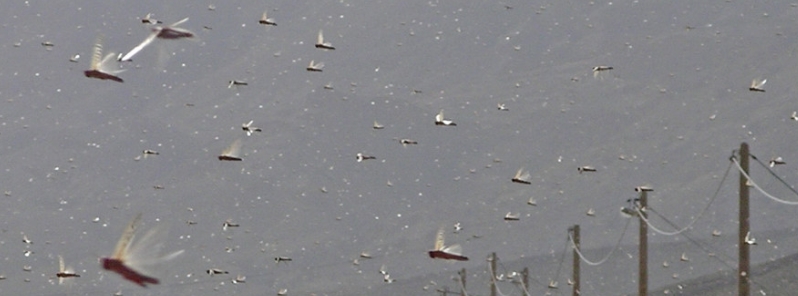Massive locust swarms attack Saudi Arabia, bigger invasion ongoing in the Horn of Africa

Massive locust swarms have invaded Saudi Arabia while a bigger and deadlier attack is ongoing in the Horn of Africa, which is set to descend on large parts of Ethiopia and Kenya, the UN Food and Agriculture Organization (FAO) warned Sunday, January 24, 2021.
In Saudi Arabia, locust swarms hit areas along the coast from Jizan to Lith, extending nearly to Duba on the north coast. Control operations are in progress, particularly against second instar hopper groups and a few bands.
Footages on social media show the insects blanketing the skies, highways, and wide fields.

Meanwhile, FAO warned Sunday that dry weather conditions across the Horn of Africa region are expected to facilitate locust swarms, making the invasion in Kenya bigger and deadlier. About 15 out of 47 counties in Kenya have been affected so far.
"As conditions remain dry in some areas, the swarms are expected to disperse throughout southern and northern Ethiopia as well as north-central Kenya," FAO wrote in its latest report.
"Any rainfall that occurs in the coming weeks will cause swarms to mature and lay eggs that will hatch and give rise to hopper bands during February and March."
Agriculture Minister Peter Munya said in a news conference that while Kenya is well-prepared to battle the second invasion, the threat is far from over.
"The [East African] country is under the second invasion by desert locusts which entered from Ethiopia and Somalia. To date, 15 counties have reported desert locust invasion."
Kenya has deployed 9 surveillance and sprayer aircraft and 21 vehicles mounted with sprayers for ground control operations. Three more aircraft are on standby.


Many farmers expressed disappointment, on the other hand, after locusts destroyed their crops and many plantations.
"These immature locusts eat as much food as their body size and are the most dangerous. They have destroyed many maize plantations. Grass for dairy cows has been decimated and trees have been broken," local farmer Kawira Mberia told Anadolu Agency.
"The farmers have suffered huge losses and the government should move in to cushion us."
FAO said intense ground and aerial control operations are ongoing in Kenya, as well as in Ethiopia, to lessen current swarm populations.
Featured image credit: Julio Era/Flickr

I’d say these videos have some biblical connotations, considering the word is in pandemic. But to each his own. If someone finds away to make this pestilence edible than habe at it.
For example, train chickens or ducks to hunt the locusts, then eat the ducks: https://www.youtube.com/watch?v=zfnKcQEYJCg
Crickets and locusts! The food of the near future:(
https://www.cnn.com/style/article/cricket-futuristic-pod/index.html
https://exoprotein.com/blogs/nutrition/eating-crickets#:~:text=Why%20Eat%20Crickets%3F-,Why%20eat%20crickets%3F,part%20of%20a%20healthy%20diet.
You are a very sick man Mr Myers. Agenda 2030 exponent perhaps?
I can’t help wondering how mankind could find a way to take advantage of this as a viable food source.